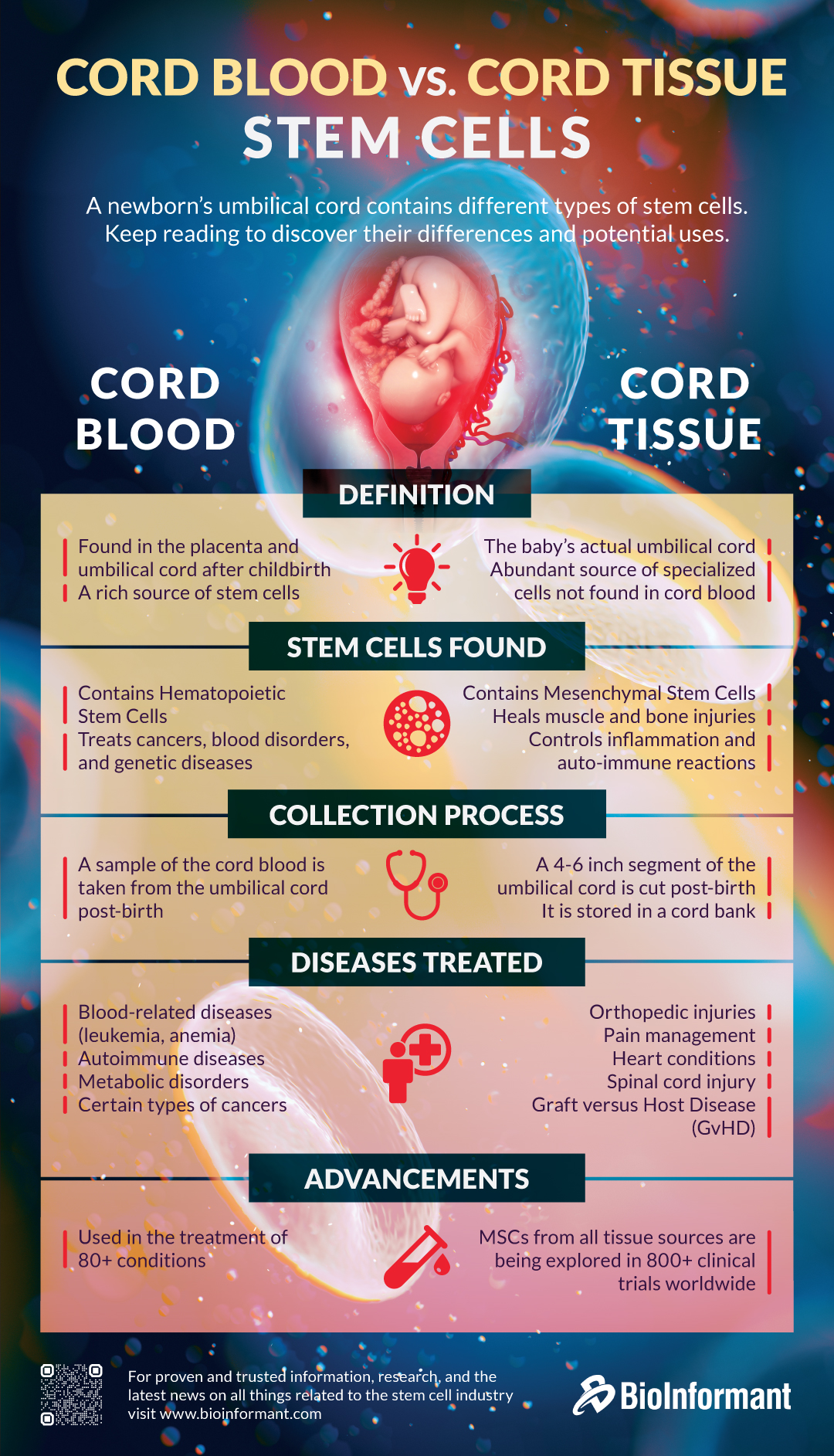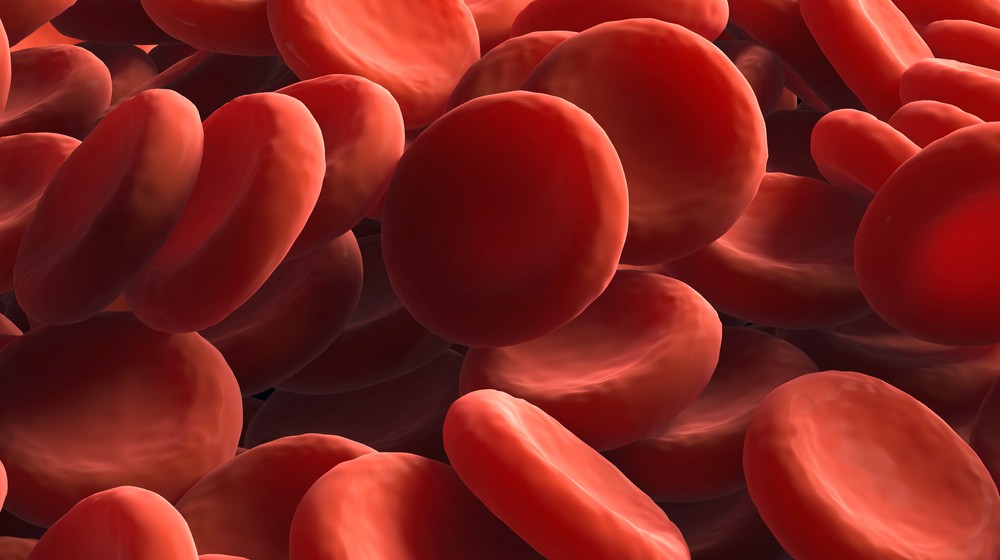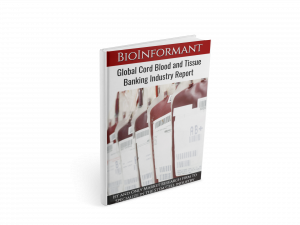|
|
There are cells contained within a newborn’s umbilical cord blood and cord tissue that can be collected and stored for future medical use. In this article, we explore the differences between these valuable cell types.
Read on to learn about the differences and potential uses of umbilical cord blood versus cord tissue stem cells.
In this article:
- Definition
- Types of Stem Cells Found
- Collection Process
- Diseases Treated
- Advancements
- Cord Blood vs. Cord Tissue
As a quick overview, the infographic below summarizes key differences between cord blood and cord tissue.

With that background context, let’s now dive into greater detail.
Definitions
First, let’s explore the definition of umbilical cord blood vs. cord tissue, because they are physically and structurally distinct.
Cord Blood
Cord blood is a rich deposit of stem cells found in the placenta and umbilical cord after childbirth. When the umbilical cord is clamped and cut during delivery, it leaves 80 to 120 ml of blood. The remaining blood is then taken from the cord and placenta using a surgical needle and stored into a sterile bag.
Although there’s only a small amount of collected blood, it is rich in a specific type of adult stem cell that can form the immune system and the blood, called a hematopoietic stem cell (HSC). After collection, these stem cells are ready to be isolated, extracted, and preserved for potential future use in treating various types of diseases.
Cord Tissue
Cord tissue is the baby’s actual umbilical cord. When the umbilical cord is clamped and cut, a 4- to 6-inch section of it can be preserved for potential future use. It is an abundant source of specialized cells, including hematopoietic stem cells (HSCs) and mesenchymal stem cells (MSCs).
Like cord blood, the type of stem cells found in the cord tissue can be collected and preserved for future medical uses.
Type of Stem Cells Found
A key difference between cord blood and cord tissue is the type of stem cells they contain.
Cord Blood
As mentioned above, the stem cells found in umbilical cord blood are called a hematopoietic stem cells (HSC). They cells tend to differentiate into the cells that form the blood and immune systems of the human body. HSCs extracted from the cord blood are considered to be more primitive than those from bone marrow or peripheral blood, with some advantages including high proliferation.
Cord Tissue
Like cord blood, cord tissue also contains some hematopoietic stem cells (HSC). However, cord tissue is also a rich source of cells called mesenchymal stem cells (MSCs). They cells tend to develop into skeletal and structural tissues, such as bone, muscle, ligaments, and tendons, for example. They are multipotent, in that they can create more than one specialized cell type. For example, they can turn into cartilage, bone, and fat cells. Each of these specialized cells has their own structures, functions, and characteristic shapes.
Collection Process
Given that cord blood is a blood-based product, while cord tissue is a tissue-based product, it makes sense that the collection process for them differs substantially.
Cord Blood
To collect cord blood, a sample of the cord blood is taken from the umbilical cord just a few minutes post-birth. Usually, the collection process starts when a surgical needle is inserted into the vein of the clamped umbilical cord for blood extraction. But, there are three ways to collect the stem cells. First is to hang a blood bag in a lower level than the mother, allowing gravity to draw blood into the tube to the bag. This method only has minimal risks for contamination and mistakes.
The second method is to actively draw blood out, like drawing blood in a medical test. It can be performed using a syringe or a bulb in the blood bag tubing for suction. This method makes drawing blood faster with larger volumes.
The last method is collecting the cord blood outside the uterus. Trained professionals wait for the placenta to be delivered, and a technician takes it into another room. They place it on a high shelf to drain all the blood from the umbilical cord.
Cord Tissue
A 4- to 6-inch segment of the umbilical cord is cut post-birth and is stored in a cord bank. Cord blood banking provides a service that includes cord tissue collection, preparation, and cryo-preservation for potential therapeutic uses. They clean and place the collected tissue in a container with antibiotics for transportation to the lab.
Diseases Treated
Next, let’s look at the list of diseases that cord blood vs. cord tissue stem cells can treat.
Cord Blood
- blood-related diseases, such as anemia and leukemia
- autoimmune diseases
- metabolic disorders
- certain types of cancer
Cord Tissue
- skeletal diseases and injuries
- inflammatory diseases
- heart diseases
- spinal cord injuries
- certain types of cancer
Research Advancements
Understandably, both cord blood and cord tissue are being explored for a wide range of therapeutics options. However, at present, umbilical cord blood has substantially more approved uses than cord tissue.
Cord Blood
Cord blood is already used in treating over 80 blood-related diseases. It has saved many lives worldwide through more than 40,000 transplants. The majority of these transplants are performed in patients younger than 18 years old. But, with the advancements in technology, it won’t be surprising if people of all ages can take advantage of its therapeutic benefits soon.
Cord Tissue
Today, cord tissue derived cells are being studied in over 200 clinical trials. For example, in the treatment of multiple sclerosis (MS), a study was conducted on 20 participants with MS with a median age of 41 years. The participants of the cord tissue research underwent stem cell therapy. Results showed they experienced improvements in their symptoms a month after the treatment.
MSCs from all sources (including cord tissue, fat, dental pulp, and other sources) are being explored in an even larger number of clinical trials worldwide.
Summarizing Umbilical Cord Blood vs. Cord Tissue
Understanding the differences and potential uses of cord blood vs. cord tissue stem cells provides a better knowledge of what to expect from them. Despite their differences, both have the potential to be used across a wide range of therapeutic applications.
To summarize what you’ve learned, watch the video below describing the difference between cord blood stem cells and cord tissue stem cells:
If you found this blog valuable, subscribe to BioInformant’s stem cell industry updates.
What questions do you have about cord blood vs. cord tissue stem cells? Ask them in comments below.





















Tell Us What You Think!